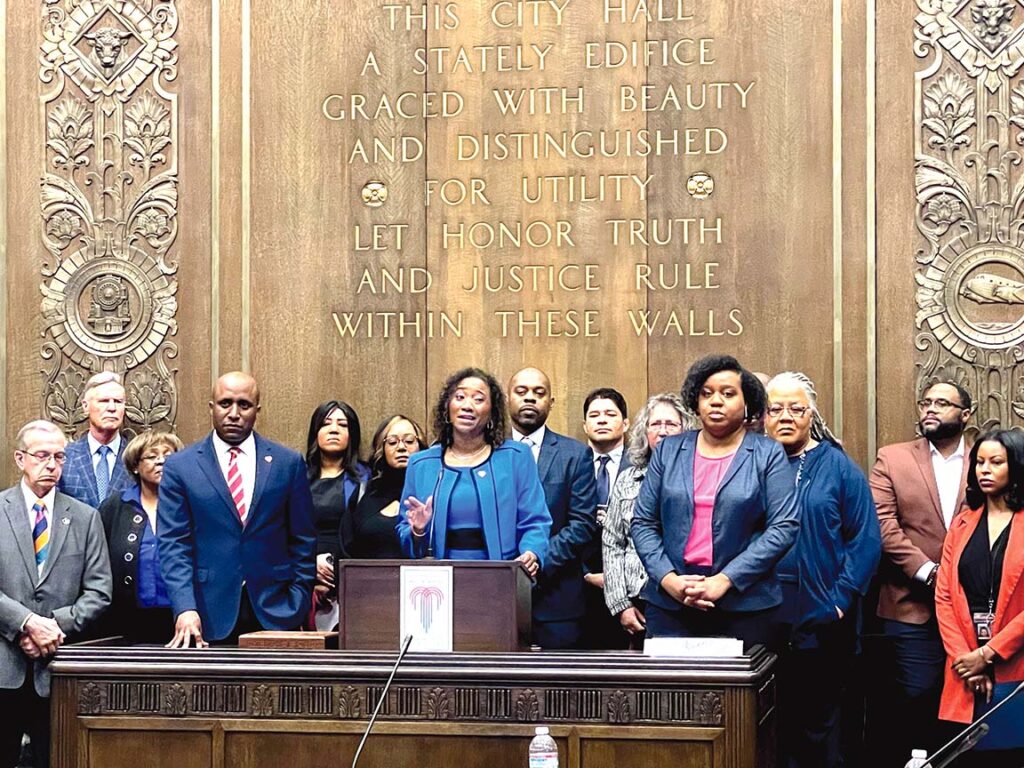
Abby Hoover
Managing Editor
Last week, nine Kansas City Council Members introduced legislation to appropriate $30 million over the next five years for violence prevention programs across the city.
The council members are now calling on the City Manager to budget the allocation of funding for $6 million each year.
“Kansas City has been one of the top cities in the nation for gun violence and homicides,” Parks-Shaw said. “Over the last three years, we have lost over 500 lives. That’s 500 sons, daughters, mothers, fathers, babies. Any loss of life reverberates through a family and a community with all stages of grief and trauma.”
In addition to the trauma associated with each homicide, experts estimate that Kansas City has an economic impact of $8.6 million per homicide. With 169 homicides last year, that’s an economic impact at $1.4 billion, Parks-Shaw said.
“Well, I’m excited to stand here today, with our village standing here,” Parks-Shaw said. “We’re here to stand and say, ‘Enough! Enough!’ The time is now for us to invest in our community, in our city, and prevent gun violence.”
Mayor Quinton Lucas, KCPD Deputy Chief Joseph Mabin and Deputy Chief Luis Ortiz, Jackson County Prosecutor Jean Peters Baker and community organizations like Kansas City Metropolitan Crime Commission, AdHoc Group Against Crime, KC Mothers in Charge, Center for Conflict Resolution, KC Common Good, Uncornered, KC 360, Partners for Peace, and the Plaza Area Council were joined by faith community leaders, school administration and neighborhood leaders.
The City Council members in support of Resolution 230129 are First District’s Kevin O’Neill, Second District’s Dan Fowler, Third District’s Brandon Ellington and Melissa Robinson, Fourth District’s Eric Bunch, Fifth District’s Lee Barnes and Ryana Parks-Shaw, and Sixth District’s Andrea Bough and Kevin McManus.
The resolution directs the City Manager to present a funding plan for the Blueprint for Violence Prevention, using $30 million from the Unappropriated Fund Balance of the General Fund, before the start of the public budget meetings. Two meetings, on February 25 at 9 a.m. and March 7 at 6 p.m., are virtual. There is a hybrid meeting on March 4 at 9 a.m. at City Hall on the 26th Floor.
With additional City funding needs in the near future, like $90 million for City Hall improvements, $10 million for the World Cup in 2024, updates to Barney Allis Plaza, a municipal jail, and up to $20 million for Enterprise Resource Planning (ERP) software, the council members are conscious of making this plan sustainable through the next five years.
Concerns were shared about how the spending would affect the City’s credit.
In 2020, the Kansas City City Council adopted the Kansas City Blueprint for Violence Prevention, a plan to reduce violence in Kansas City with collaborative partners and community organizations. Since then, Kansas City has seen more than 500 homicides and had its three deadliest years on record. These City Council members have come together to propose legislation to finally implement the KC Blueprint, KC 360 and Partners for Peace.
“Due to budget constraints, and a pandemic, we could not make the necessary investment to adequately fund the implementation of the plan,” Parks-Shaw said. “With the City Council’s current financial situation, now’s the time to increase that investment in our youth and our communities.”
The City currently spends just over $16 million on violent prevention programs. With additional funding and implementation of the KC Blueprint, the City would work on initiatives like access to affordable mixed income housing, reforming TIF policies to prevent exploitation of blight, investing in libraries, parks and community centers, including residents from impacted areas in workforce for City-funded projects, investing in neighborhood associations and neighborhood-level community workers, adopting and enforcing policies to regulate the sale of alcohol and revising zoning ordinances around gun shows.
They would also expand outreach to connect at-risk youth and adults with resources, promote development of small businesses within impacted neighborhoods, invest in quality early childcare, ensure that City staff reflect the demographics of the community, invest more in youth employment programs, contract with businesses that pay at least $15/hour, implement training focused on implicit bias and emphasize dignity and respect, and require trauma-informed care training.
On Tuesday, Feb. 7, Lucas hosted a roundtable discussion with U.S. Marshal Service Deputy Director Roberto Robinson, local youth impacted by gun violence, and community organizations including Lyrik’s Institution, Moms Demand Action, Corey’s Network, and Ad Hoc Group Against Crime. Jackson County Prosecutor Jean Peters Baker, KCPS Superintendent Dr. Jennifer Collier, and KCPD Police Chief Stacey Graves also joined the discussion.
The discussion focused on violent crime issues impacting Kansas City youth. Firearms are the leading cause of death for children and teens in the United States. Every year, 18,000 children and teens are shot and killed or wounded and about 3 million are exposed to gun violence, according to data from Everytown for Gun Safety.
“At the end of the panel, we were asking this 15-year-old, ‘Where does someone your age or younger get a gun?’ And as he was shrugging his shoulders, he said, ‘Easy. If I have $100, I can get almost any firearm that I want,’’ Lucas shared at Wednesday’s press conference. “These are the sorts of things that confront our youth right now. In some communities, it’s easier to get a gun than fresh produce. In some communities, it’s easier to get access to gang members and violence than it is to get mentorship from adults and others, and this is where we’re looking to fundamentally change it.”
Lucas and McQueen announced news of two grants they received to fund a youth development program and re-entry support program.
Faced with some of the deadliest years on record, Kansas City’s elected leaders and community groups are hoping an influx of funding will be the boost they need to make meaningful steps toward success in violence prevention.

















